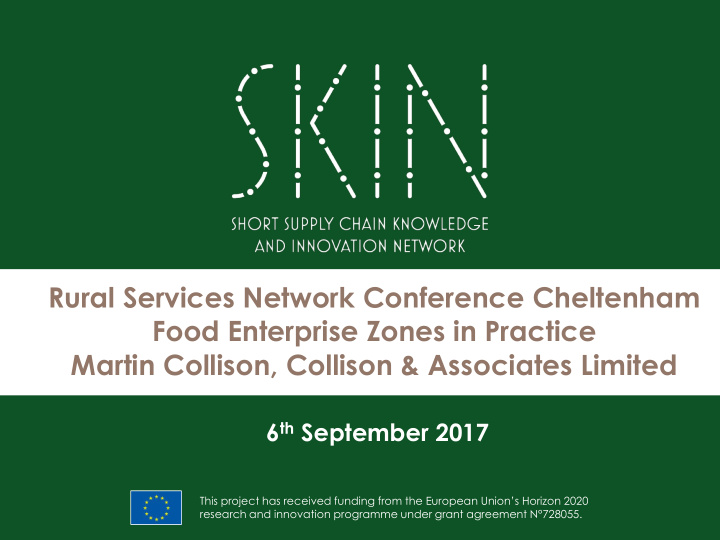



Rural Services Network Conference Cheltenham Food Enterprise Zones in Practice Martin Collison, Collison & Associates Limited 6 th September 2017 This project has received funding from the European Union’s Horizon 2020 research and innovation programme under grant agreement N°728055.
SKIN project SKIN is an EU Thematic Network, which over 3 years will share knowledge on Short Food Chains across Europe It builds on a Focus Group run in 2014/15 by the EU on Short Food Chains (SFCs) SFCs are where the end consumer and farmer/food producer are in closer contact and more value is created for the primary producer The opposite of long supply chains which led to Horsegate … www.shortfoodchain.eu 2
Short Food Chains Stansted airport summer 2017 - power of local food: www.shortfoodchain.eu 3
Local Food Lots of definitions for local, regional, speciality etc. food ..…. … but businesses are interested because consumers are increasingly keen on provenance & locality www.shortfoodchain.eu 4
Martin’s background Farmer, wholesaler, consultant, academic and policy Food Chain work includes: • Food chain development for farms and food cos. • Every level from farms and district councils to EU • East of England Local Food Campaigns 2002-08 • DEFRA local food group 2005/08 • Local to London Food Group 2006/08 • Norfolk Food Hub since 2008, now Norfolk FEZ • Lecture at National Centre for Food Manufacturing • EU Focus Group on Short Food Chains 2014/15 • Greater Lincolnshire agrifood lead since 2014 • SKIN project since late 2016 www.shortfoodchain.eu 5
Food Enterprise Zones (FEZs) FEZs were proposed by then DEFRA Secretary of State Liz Truss in autumn 2015 with a very short window to bid In Greater Lincolnshire we bid for 3 FEZs: • Europarc 4 in Grimsby • Central Lincolnshire Hemswell Cliff (former MOD site) • Holbeach A 2 nd round in spring 2016 led to the Greater Norwich FEZ including the Norfolk Food Hub, taking the total to 17 FEZs across the country www.shortfoodchain.eu 6
Focus DEFRA was (deliberately) vague & open about what a FEZ should be … quite rightly in my view as there are so many different needs All, however: • Are focused on food chain development & growth • Based on a Local Development Order (LDO) to accelerate & de-risk planning for food companies • Encourage co-location & cluster development All have adopted a different focus to food chain development www.shortfoodchain.eu 7
What they are not They are not full Enterprise Zones with the rate relief & other incentives that come with these – although a few have now via Growth Deals gained this status But, local partners: landowners, councils, LEPs, skills providers & grant bodies can choose to provide incentives for companies in or linked to FEZs This is what we have chosen to do in Greater Lincolnshire & are now seeking to develop in Norfolk www.shortfoodchain.eu 8
What are the challenges (1) Getting the LDO approved is not a quick process – because once approved planners lose some control … but for companies & developers they do de -risk & speed up development once in place Competing with full Enterprise Zones can be a challenge given the incentives in EZs especially if a FEZ has an EZ in the nearby area They require partners to come together to promote the food chain & this needs to start early & continue for years to make a real impact www.shortfoodchain.eu 9
What are the challenges (2) As with any big development: • Highways • Power & in some cases water, telecoms etc. • On site infrastructure • Speculative builds create finance & revenue issues (e.g. rates) • CIL & other infrastructure charges add costs Food chain uses need a lot of space & food/rural rents lower – thus the business case for the developer can be poor & can need assistance www.shortfoodchain.eu 10
Where are the opportunities in the food chain? UK Consumer spending on food now over £200bn & rising 2-3% per annum UK’s largest manufacturing sector Global spending is circa $8trillion (5 times as large as the automotive sector) & growing at 6% per annum UK ratio consumer value to farmgate value 6:1 – globally 2:1, but will rise as wealth continues to grow UK food exports now over £20billion & have risen every year since 2004, but still a big trade gap www.shortfoodchain.eu 11
Where are the opportunities in the food chain? (2) Brexit means a focus on both import substitution & global exports Competitiveness means we need more efficient food chains – short food chains reduce the steps in the chain & get more value back to the 1 o producer Consumers in the UK & globally want more traceability, provenance, convenience & quality www.shortfoodchain.eu 12
The Opportunity FEZs are not the answer on their own, but as part of a package of investment in the regional food chain can work well to create the physical space to support food chain growth Need to be aligned with other incentives, business support & skills The SKIN network aims to promote exemplars of what works from across Europe to help 1 o producers get a larger share of the final consumer value www.shortfoodchain.eu 13
Debate (1) What is the food sector growth potential in your area? • Farming / commodity production • Adding value to food through processing, marketing, distribution, niche markets, exports • And/or a focus on productivity & efficiency What are the constraints on moving the food industry forward? www.shortfoodchain.eu 14
Debate (2) What can you do to grow your food economy? • Premises & planning • Business support • Skills • Innovation • Networks & best practice • Grants for investment www.shortfoodchain.eu 15
THANK YOU ! Martin Collison martin@collisonassociates.co.uk (01553) 828 405, (07802) 480 848 16
Recommend
More recommend